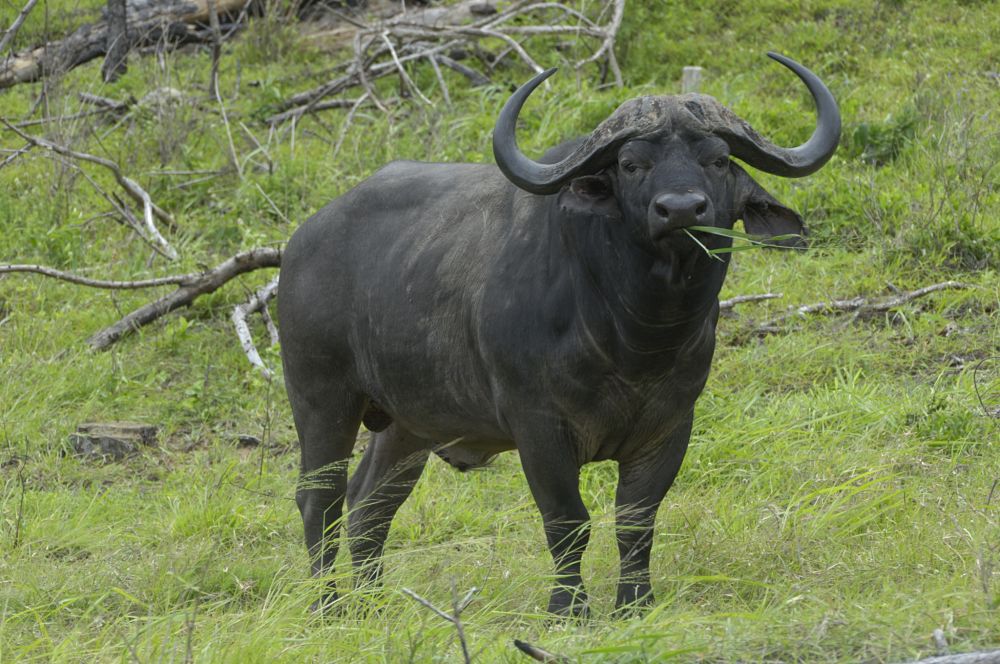Post by rock on Jun 18, 2019 19:53:27 GMT 5
African Cape Buffalo - Syncerus caffer
The African buffalo, affalo, nyati, Mbogo or Cape buffalo (Syncerus caffer) is a large African bovine. It is not closely related to the slightly larger wild Asian water buffalo, but its ancestry remains unclear. Owing to its unpredictable nature which makes it highly dangerous to humans, it has not been domesticated, unlike its Asian counterpart, the domestic Asian water buffalo. The Cape buffalo is a very robust species. Its shoulder height can range from 1 to 1.7 m (3.3 to 5.6 ft) and its head-and-body length can range from 1.7 to 3.4 m (5.6 to 11 ft). The tail can range from 70 to 110 cm (28 to 43 in) long. Savannah type buffaloes weigh 500 to 910 kg (1,100 to 2,000 lb), with males, normally larger than females, averaging 768 kg (1703 lbs). A record-sized savannah-type male weighed 1,000 kg (2,200 lb). Forest type buffaloes, at 250 to 455 kg (550 to 1,000 lb), are only half that size. Its head is carried low, its top located below the backline. The front hooves of the buffalo are wider than the rear, which is associated with the need to support the weight of the front part of the body, which is more powerful than the back.

bull moose-Alces alces
The moose (North America) or Eurasian elk (Europe) (Alces alces) is the largest extant species in the deer family. Moose are distinguished by the palmate antlers of the males; other members of the family have antlers with a dendritic ("twig-like") configuration. Moose typically inhabit boreal and mixed deciduous forests of the Northern Hemisphere in temperate to subarctic climates.
On average, an adult moose stands 1.8–2.1 m (6–7 ft) high at the shoulder. Males weigh 380–720 kg (850–1580 pounds) and females weigh 270–360 kg (600–800 pounds). The largest of all is the Alaskan subspecies (A. a. gigas), which can stand over 2.1 m (7 ft) at the shoulder, has a span across the antlers of 1.8 m (6 ft) and averages 634.5 kg (1,396 lbs) in males and 478 kg (1,052 lbs) in females. Typically, however, the antlers of a mature specimen are between 1.2 m (3.9 ft) and 1.5 m (4.9 ft). The largest confirmed size for this species was a bull shot at the Yukon River in September 1897 weighing 816 kg (1,800 lb) and was 233 cm (92 in) tall at the shoulder. The Moose of Alaska matches the extinct Irish Elk as the largest deer of all time. Behind only the bison, the Moose is the second largest land animal in both North America and Europe. The life span of an average moose is about 15–25 years.

The African buffalo, affalo, nyati, Mbogo or Cape buffalo (Syncerus caffer) is a large African bovine. It is not closely related to the slightly larger wild Asian water buffalo, but its ancestry remains unclear. Owing to its unpredictable nature which makes it highly dangerous to humans, it has not been domesticated, unlike its Asian counterpart, the domestic Asian water buffalo. The Cape buffalo is a very robust species. Its shoulder height can range from 1 to 1.7 m (3.3 to 5.6 ft) and its head-and-body length can range from 1.7 to 3.4 m (5.6 to 11 ft). The tail can range from 70 to 110 cm (28 to 43 in) long. Savannah type buffaloes weigh 500 to 910 kg (1,100 to 2,000 lb), with males, normally larger than females, averaging 768 kg (1703 lbs). A record-sized savannah-type male weighed 1,000 kg (2,200 lb). Forest type buffaloes, at 250 to 455 kg (550 to 1,000 lb), are only half that size. Its head is carried low, its top located below the backline. The front hooves of the buffalo are wider than the rear, which is associated with the need to support the weight of the front part of the body, which is more powerful than the back.

bull moose-Alces alces
The moose (North America) or Eurasian elk (Europe) (Alces alces) is the largest extant species in the deer family. Moose are distinguished by the palmate antlers of the males; other members of the family have antlers with a dendritic ("twig-like") configuration. Moose typically inhabit boreal and mixed deciduous forests of the Northern Hemisphere in temperate to subarctic climates.
On average, an adult moose stands 1.8–2.1 m (6–7 ft) high at the shoulder. Males weigh 380–720 kg (850–1580 pounds) and females weigh 270–360 kg (600–800 pounds). The largest of all is the Alaskan subspecies (A. a. gigas), which can stand over 2.1 m (7 ft) at the shoulder, has a span across the antlers of 1.8 m (6 ft) and averages 634.5 kg (1,396 lbs) in males and 478 kg (1,052 lbs) in females. Typically, however, the antlers of a mature specimen are between 1.2 m (3.9 ft) and 1.5 m (4.9 ft). The largest confirmed size for this species was a bull shot at the Yukon River in September 1897 weighing 816 kg (1,800 lb) and was 233 cm (92 in) tall at the shoulder. The Moose of Alaska matches the extinct Irish Elk as the largest deer of all time. Behind only the bison, the Moose is the second largest land animal in both North America and Europe. The life span of an average moose is about 15–25 years.





